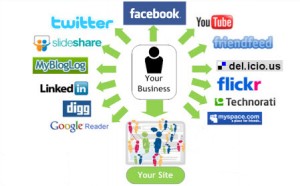 So you want to take your involvement in music to the next step. You’ve been DJing for a couple of years and have been producing music that’s unique; your own style or take that the industry might not be ready for- not yet at least! You’ve got a crew of friends who are producing music that’s equally as good as it is underground. You’ve played your tracks out at gigs and get a great reaction but for some reason, you’re not hearing back from record labels you’re reaching out to. How is the world going to hear your music if no one is giving you a shot?
So you want to take your involvement in music to the next step. You’ve been DJing for a couple of years and have been producing music that’s unique; your own style or take that the industry might not be ready for- not yet at least! You’ve got a crew of friends who are producing music that’s equally as good as it is underground. You’ve played your tracks out at gigs and get a great reaction but for some reason, you’re not hearing back from record labels you’re reaching out to. How is the world going to hear your music if no one is giving you a shot?
The internet has leveled and broadened the playing field as far as the opportunity to get your music heard is concerned. From Soundcloud accounts to Youtube profiles, the internet has enhanced your ability to share your music in ways that you couldn’t dream of in 1990, when selling tapes and CDs out of your the trunk of your car was the most viable option to reach an audience. With the help of a computer, an internet connection and access to bandwidth, you’re ready to become leader of your own netlabel.
Simply put, a netlabel is a record label that releases music online. The standard protocol among netlabels is a mandate to provide music for free, as part of a greater calling to make music more accessible to the public, however this is just one of the many decisions you have to make as you decide how to structure your new endeavor
Lets Get Started
First off; you need a name. With a name comes identity, out of identity comes a brand, and through your brand comes a purpose and expectation you set among your audience for the type of material you’re looking to release. Your name can link to a concept, the genre, the motto of your crew; whatever it ends up being, make sure that it serves as a window to your vision for others to see. After deciding on a name, reach out to friends who are graphic designers, or commission someone to create a logo for you, if you don’t know how to make one yourself. Your logo is the visual element that will connect to your audience and create a sense of continuity in your releases. Think about the Nike “swoosh” logo. When you see it appear onscreen, you know exactly the kind of product that is being promoted and sold; your logo serves the same purpose musically.

Brand/Identity Logo nexus by Justcreative
Along with your logo, is the “look” of your releases. Maintain a consistent appearance that connects your website, logo and cover photos for your releases together. Aesthetic is important, so make sure that your designs all connect to one another. It will help establish the “brand” of your netlabel, with every release you make helping reinforce your brand. Remember simplicity is timeless, so don’t let current trends dictate the look of your label and its releases.
Once you’ve got your heart set on a name and have your logo designed, you need to register your netlabel with an archiving website of sorts. Archive.org is a popular destination because it’s free, and was founded as a non-profit public library to ensure permanent access of collections to the public. After you’re registered with an appropriate host, make sure you’re able to secure a website under the same name. While Facebook pages are an incredibly effective means to promote your releases (we’ll discuss this later) you have to remember that a web presence is necessary because not everyone is on Facebook.
Not a programmer? Don’t worry- registering and managing a website is easy! Convenient and user friendly sites help immeasurably, allowing you to set up a free domain through blog-like-formats like Tumblr, blogspot or WordPress. You can also go one step further and personally design a website using templates available from sites like Wix. Make sure you set aside money in your budget to gain ownership of a URL for your website to exclusively use.
 Once you’ve got the basic parts of your netlabel ready, make sure you register and establish an identity on social media presence on platforms like Twitter, Facebook, Youtube, Vimeo, Soundcloud and Bandcamp. Social media presence means that your potential fans- DJ’s, producers, members of the media as well as average folks like you and me, have the ability to seek you out, make contact and enjoy your music through whichever medium they use. In addition, content available through social media increases the probability for your releases to go viral, so if you’re using twitter to promote your music, by all means, put a hashtag on it!
Once you’ve got the basic parts of your netlabel ready, make sure you register and establish an identity on social media presence on platforms like Twitter, Facebook, Youtube, Vimeo, Soundcloud and Bandcamp. Social media presence means that your potential fans- DJ’s, producers, members of the media as well as average folks like you and me, have the ability to seek you out, make contact and enjoy your music through whichever medium they use. In addition, content available through social media increases the probability for your releases to go viral, so if you’re using twitter to promote your music, by all means, put a hashtag on it!
After registering your website, make sure you also create an RSS feed. An RSS feed stands for “Really Simple Syndication”. It allows fans of your website to register their email accounts to receive automatic updates whenever you publish new content –your release of a new single or album. Prior to releasing your music, make sure legally protect your content by establishing a common creative license, which simply put, allows you to use “some rights reserved” copyright protections for free.
With Basics Set You’re Ready To Launch
Once you have the bare basics completed -a place for you to host your music, on platforms people can easily find you through, with a framework for your future releases- then you’re ready for the next step.
Earlier I noted that you’ve got a crew of friends who are talented and release music too. This is important because you cannot build, manage and run your website as well as produce tracks and remix them all by yourself. Make sure you diversify the number of folks involved with your label. If you produce a single that you’re proud of, make sure you reach out to a couple friends whose taste in music and productions you trust, and ask them to remix it. This will help in a number of ways. It will help to:
- Branch out the sound of your release and by extension your label.
- Involving friends/professional contacts that you reach out to will expand the artistic family of your label. Artists who have a remix that’s being released will promote the label that their work is featured in. This is going to broaden your promotional power and reach.
- Growing the community of artists that release within your label gives a chance for those artist to collaborate with each other. Help connect artists whose sounds you think compliment each other and encourage them to join forces. This can be a beautiful place where magic happens, so make sure you help facilitate releases that could help both artists out with a release that will strengthen your label.
Make sure you have a concept for your label that feeds its identity. This can be rooted in the sound of your releases -from your take on deep techno or chilled out ambient- to a more abstract take like tracks over 8 minutes or music made out of sounds from one room in your house- kitchen techno anyone? However you decide to establish the domain in which your label’s sound will operate, make sure it’s clear. It will help set an expectation among your audience that will tie in the sound of all your releases. Otherwise, your label won’t establish a name for anything other than a scattered sound- while diversity is good, disorganization is not.

Minus Records’ logo is a clever use of minus’ symbolic value, deleting the “I” to reinforce Ritchie Hawtin’s vision for his label as an artistic home “inspired by theories of subtraction, advancement and experimentation”. This is branding at its most clever.
A nice way to compliment the sound of your label is to create a podcast series. Ask artists you consider taking under your wing to record a set that includes their tracks. It will help reinforce the ties between your artists and your label. Fans of your podcasts will know where they can go to find the music you release, building the popularity and reputation of your label. For more examples of ways to engage your audience, take a look at Ritchie Hawtin’s Minus Records website, where you can listen to exclusive podcasts and sets by featured artists as well as see live performances and/or promotional videos, to help follow the lead of one of minimal techno’s most successful and established brands.
Make sure that you have a timely schedule for your releases and stick to it. The best way to ruin the credibility of your label is to release a lot of music for the sake of releasing music, as opposed to staying mindful of the quality of music you’re going to be associated with. Schedule releases often enough to stay relevant but space them out enough to give you time to release what you want to. Remember, quality wins over quantity every single time.
With content ready for release, now you have to decide whether your music will be distributed for free or if they will be available for purchase. There are equally valid arguments for pursuing either route, just be upfront with your audience. Irene Test of Crossfadr helps break it down for you in her most recent post. Make sure you give it a read and decide for yourself. If you do decide to charge for your music, Bandcamp is a great place to start, costing only 15% per transaction, artists stand to receive 85% from each users purchase.
Once you’ve got content ready to release, make sure you promote your work using the social media platforms you’ve registered your site on. Publicize your singles and EPs by making simple videos that can be found on Youtube and Vimeo. Promote those links, as well as links to your website, on Facebook, Google+ and Twitter and watch your releases build the popularity of your label. Once you’ve established a bit of credibility, organize a label party that gives your artists a chance to play their music out and establish your label as a force to be reckoned with.
For examples of successful netlabels you can model your own after, take a look at a couple of my favorites: Music Kollektiv and Bleep Sequence.





